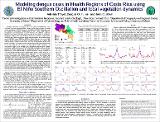Mostrar el registro sencillo del ítem
Modeling dengue cases in health Regions of Costa Rica using El Niño Southern Oscillation and local vegetation dynamics
| dc.creator | Troyo Rodríguez, Adriana | |
| dc.creator | Fuller, Douglas O. | |
| dc.creator | Beier, John C. | |
| dc.date.accessioned | 2019-02-26T13:40:22Z | |
| dc.date.available | 2019-02-26T13:40:22Z | |
| dc.date.issued | 2009-11 | |
| dc.identifier.uri | https://hdl.handle.net/10669/76613 | |
| dc.description.abstract | Temporal behavior of dengue fever and dengue hemorrhagic fever (DH/DHF) has been associated with climate, which may modulate mosquito vector populations. El Niño Southern Oscillation (ENSO) fluctuations can be related to sea-surface temperatures in the Pacific that influence precipitation and temperature in Latin America. In addition, vegetation dynamics have been associated with DF/DHF at local scales. In this study, vegetation indices from the Moderate Resolution Imaging Spectrometer (MODIS) and Pacific sea-surface temperature anomalies were used to model weekly DF/DHF cases (2003 to 2007) in Costa Rica and its nine Health Regions (HR). Using cross correlation analyses, positive and negative lags were identified, where DF/DHF cases and each independent variable were better correlated. A sinusoid and non-linear least squares model was applied to fit case data for the county and HR using lagged variables. The countywide model, where variables were lagged according to their highest correlation coefficient, had an R2 of 0.86. Models including either only the positive or only the negative lags of variables had R2 values of 0.60 and 0.84, respectively. These models were all able to reproduce a major epidemic in 2005. Model performance differed between HR, with R2 values from 0.41 (a region with few cases and slight wet/dry seasonality) to 0.85 (a region with marked seasonality and >20,000 cases). Results show that climate and vegetation dynamics are good predictors of DF/DHF cases in Costa Rica. The differences in model fits for HR may be due in part to local conditions that can affect transmission such as altitude, temperature, socioeconomic conditions, prevention and control actions, and human behavior. Moreover, these models may be improved further by using other variables like Atlantic sea surface temperatures. Considering that the HR of Costa Rica may represent conditions common to areas of Latin America and the Caribbean, these models may be applicable to various countries and function as an early warning system to predict epidemics in areas affected by dengue. | es_ES |
| dc.description.sponsorship | Universidad de Costa Rica/[803-A6-401]/UCR/Costa Rica | es_ES |
| dc.description.sponsorship | Universidad de Costa Rica/[803-A6-039]/UCR/Costa Rica | es_ES |
| dc.description.sponsorship | Universidad de Costa Rica/[803-A9-519]/UCR/Costa Rica | es_ES |
| dc.language.iso | es | es_ES |
| dc.source | Annual meeting of American Society of Tropical Medicine and Hygiene, 18-22 november 2009, Washington USA | es_ES |
| dc.subject | Dengue | es_ES |
| dc.subject | Clima | es_ES |
| dc.subject | Costa Rica | es_ES |
| dc.subject | 616.921 728 6 Fiebre de dengue | es_ES |
| dc.title | Modeling dengue cases in health Regions of Costa Rica using El Niño Southern Oscillation and local vegetation dynamics | es_ES |
| dc.type | contribución de congreso | |
| dc.type | póster de congreso | |
| dc.date.updated | 2018-12-19T21:19:12Z | |
| dc.description.procedence | UCR::Vicerrectoría de Investigación::Unidades de Investigación::Ciencias de la Salud::Centro de Investigación en Enfermedades Tropicales (CIET) | es_ES |
| dc.description.procedence | UCR::Vicerrectoría de Docencia::Salud::Facultad de Microbiología | es_ES |
| dc.identifier.codproyecto | 803-A6-401 | |
| dc.identifier.codproyecto | 803-A6-039 | |
| dc.identifier.codproyecto | 803-A9-519 |
Ficheros en el ítem
Este ítem aparece en la(s) siguiente(s) colección(ones)
-
Microbiología [1171]



